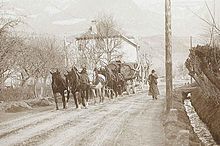Wagon
A wagon is one of draft animals drawn carriage . The outdated term Stellwagen has been preserved in the job title of Stellmacher for the wagon builder.
Terms wagon, cart and wagon
The beginnings and developments of vehicles are comprehensively dealt with under the heading of wagons .
Carts and wagons are means of transport on land that consist of a flat loading area, a box with or without doors and a hood or a similar construction made of e.g. T. very different materials. It is mounted on a single or on several axes and is relatively easy to move thanks to rolling friction; A route or road is not essential for movement, but it is an advantage; also a draft animal or human is required to overcome the rolling friction. The carriage differs from sledges , bar loops and similar means of transport that operate with sliding friction. It represents a significant step forward for long-distance and mass transports, especially compared to transport (pack donkeys, pack animals, box carriers and the like).
Until the invention of mechanical drives, the wagons were dependent on draft animals, then together with the harnessed donkeys , oxen , horses (or other draft animals) they were called carts. With the technical development, many terms have shifted. In the 19th century, for example, a truck usually meant a type of wagon; today truck is synonymous with truck .
Construction types of wagons
Robust versions were the cart wagons common in agriculture , named after the surrounding railing, and the covered wagon used as a trading wagon and by emigrants , English waggon (also rail freight wagons). The trailer was used to transport construction timber or round timber .
Depending on the design, there were a large number of different terms for wagons for passenger transport such as:
- Carriage (sprung, with hood)
- Body (representative)
- Kremser (covered wagon with benches as rental car)
- Fiaker and cab (the horse-drawn forerunners of today's taxis)
- Stagecoach, Stellwagen, society car, etc. ( horse omnibus , the horse-drawn forerunner of today's bus)
In the city center of Schwäbisch Gmünd , the urban plants have been watered by a horse-drawn vehicle with a water tank since 1992.
Use of draft animals
- Harness (draft animal)
- Yoke harness
- Collar harness
- Tension
- horse drawn carriage
- Mule
- Draft ox
- Dog cart
Individual evidence
- ↑ History of the car and the wheelwright trade ( Memento of December 10, 2004 in the Internet Archive )
- ↑ One PS for 160 flower pots , Gmünder Tagespost , article from July 31, 2015
literature
- H.Dv. 476/1 - General army equipment, vehicles, from May 22, 1936, ISBN 978-3743139824








